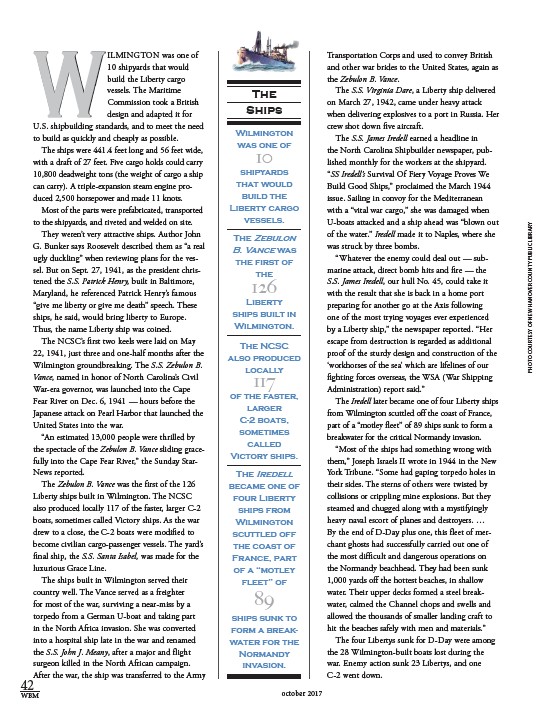
ILMINGTON was one of
10 shipyards that would
build the Liberty cargo
vessels. The Maritime
Commission took a British
design and adapted it for
U.S. shipbuilding standards, and to meet the need
to build as quickly and cheaply as possible.
The ships were 441.4 feet long and 56 feet wide,
with a draft of 27 feet. Five cargo holds could carry
10,800 deadweight tons (the weight of cargo a ship
can carry). A triple-expansion steam engine pro-duced
2,500 horsepower and made 11 knots.
Most of the parts were prefabricated, transported
to the shipyards, and riveted and welded on site.
They weren’t very attractive ships. Author John
G. Bunker says Roosevelt described them as “a real
ugly duckling” when reviewing plans for the ves-sel.
But on Sept. 27, 1941, as the president chris-tened
the S.S. Patrick Henry, built in Baltimore,
Maryland, he referenced Patrick Henry’s famous
“give me liberty or give me death” speech. These
ships, he said, would bring liberty to Europe.
Thus, the name Liberty ship was coined.
The NCSC’s first two keels were laid on May
22, 1941, just three and one-half months after the
Wilmington groundbreaking. The S.S. Zebulon B.
Vance, named in honor of North Carolina’s Civil
War-era governor, was launched into the Cape
Fear River on Dec. 6, 1941 — hours before the
Japanese attack on Pearl Harbor that launched the
United States into the war.
“An estimated 13,000 people were thrilled by
the spectacle of the Zebulon B. Vance sliding grace-fully
into the Cape Fear River,” the Sunday Star-
News reported.
The Zebulon B. Vance was the first of the 126
Liberty ships built in Wilmington. The NCSC
also produced locally 117 of the faster, larger C-2
boats, sometimes called Victory ships. As the war
drew to a close, the C-2 boats were modified to
become civilian cargo-passenger vessels. The yard’s
final ship, the S.S. Santa Isabel, was made for the
luxurious Grace Line.
The ships built in Wilmington served their
country well. The Vance served as a freighter
for most of the war, surviving a near-miss by a
torpedo from a German U-boat and taking part
in the North Africa invasion. She was converted
into a hospital ship late in the war and renamed
the S.S. John J. Meany, after a major and flight
surgeon killed in the North African campaign.
After the war, the ship was transferred to the Army
The
Ships
42
WBM october 2017
Transportation Corps and used to convey British
and other war brides to the United States, again as
the Zebulon B. Vance.
The S.S. Virginia Dare, a Liberty ship delivered
on March 27, 1942, came under heavy attack
when delivering explosives to a port in Russia. Her
crew shot down five aircraft.
The S.S. James Iredell earned a headline in
the North Carolina Shipbuilder newspaper, pub-lished
monthly for the workers at the shipyard.
“SS Iredell’s Survival Of Fiery Voyage Proves We
Build Good Ships,” proclaimed the March 1944
issue. Sailing in convoy for the Mediterranean
with a “vital war cargo,” she was damaged when
U-boats attacked and a ship ahead was “blown out
of the water.” Iredell made it to Naples, where she
was struck by three bombs.
“Whatever the enemy could deal out — submarine
attack, direct bomb hits and fire — the
S.S. James Iredell, our hull No. 45, could take it
with the result that she is back in a home port
preparing for another go at the Axis following
one of the most trying voyages ever experienced
by a Liberty ship,” the newspaper reported. “Her
escape from destruction is regarded as additional
proof of the sturdy design and construction of the
‘workhorses of the sea’ which are lifelines of our
fighting forces overseas, the WSA (War Shipping
Administration) report said.”
The Iredell later became one of four Liberty ships
from Wilmington scuttled off the coast of France,
part of a “motley fleet” of 89 ships sunk to form a
breakwater for the critical Normandy invasion.
“Most of the ships had something wrong with
them,” Joseph Israels II wrote in 1944 in the New
York Tribune. “Some had gaping torpedo holes in
their sides. The sterns of others were twisted by
collisions or crippling mine explosions. But they
steamed and chugged along with a mystifyingly
heavy naval escort of planes and destroyers. …
By the end of D-Day plus one, this fleet of mer-chant
ghosts had successfully carried out one of
the most difficult and dangerous operations on
the Normandy beachhead. They had been sunk
1,000 yards off the hottest beaches, in shallow
water. Their upper decks formed a steel break-water,
calmed the Channel chops and swells and
allowed the thousands of smaller landing craft to
hit the beaches safely with men and materials.”
The four Libertys sunk for D-Day were among
the 28 Wilmington-built boats lost during the
war. Enemy action sunk 23 Libertys, and one
C-2 went down.
Wilmington
was one of 10
shipyards
that would
build the
Liberty cargo
vessels.
The Zebulon
B. Vance was
the first of
the 126
Liberty
ships built in
Wilmington.
The NCSC
also produced
locally 117
of the faster,
larger
C-2 boats,
sometimes
called
Victory ships.
The Iredell
became one of
four Liberty
ships from
Wilmington
scuttled off
the coast of
France, part
of a “motley
fleet” of
89
ships sunk to
form a break-water
for the
Normandy
invasion.
PHOTO COURTESY OF NEW HANOVER COUNTY PUBLIC LIBRARY
W